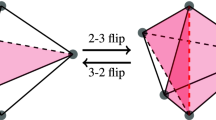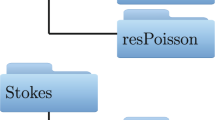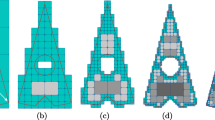Abstract
A method for smoothing hexahedral meshes has been developed. The method consists of two phases. In the first phase, the nodes are moved based on an explicit formulation. A constraint has also been implemented to prevent the deterioration of elements associated with the node being moved. The second phase of the method is optismoothing based on the Nelder–Mead simplex method. The summation of the Jacobian of all the elements sharing a node has been taken as the function to be maximized. The method has been tested on meshes up to 18,305 hexahedral elements and was found to be stable and improved the mesh in about 112.6 s on an Intel Centrino® 1.6 GHz, 1 GB RAM machine. The method thus has the advantage of being effective as well as being computationally efficient.









Similar content being viewed by others
References
White DR, Mingu L, Benzley SE, Sjaardema GD (1995) Automated hexahedral mesh generation by virtual decomposition. In: Proceedings of 4th international meshing roundtable. Sandia National Laboratories, California, pp 165–176
Knupp PM (1998) Next generation Sweep Tool: a method for generating all hex meshes on a two and one half dimensional geometries. In: Proceedings of 7th international meshing roundtable. Sandia National Laboratory, California, pp 505–513
Folwell NT, Mitchell SA (1999) Reliable whisker weaving via curve contraction. Eng Comput 15:292–302
Jankovich SR, Benzley SE, Shepherd JF, Mitchell SA (1999) The Graft Tool: an all-hexahedral transition algorithm for creating a multi-directional swept volume mesh. In: 8th international meshing roundtable. S. Lake Tahoe, CA, pp 387–392
Owen SJ, Saigal S (2000) H-Morph: an indirect approach to advancing from hex meshing. Int J Numer Methods Eng 49:289–312
White D, Rodrigue G (1997) Improved vector FEM solutions of Maxwell’s equations using grid pre-conditioning. Int J Numer Meth Eng 40:3815–3837
Shontz SM, Vavasis SA (2004) A linear weighted laplacian smoothing framework for warping tetrahedral meshes. CS.NA/0410045. October 2004
Persson P-O, Strang G (2004) A simple mesh generator in MATLAB. SIAM Rev 46(2):329–345
Canann SA, Stephenson MB, Blacker T (1993) Optismoothing: an optimization-driven approach to mesh smoothing. Finite Elem Anal Des 13:185–190
Cannan SA, Tristano JR, Staten ML (1998) An approach to combined Laplacian and optimization-based smoothing for triangular, quadrilateral, and quad-dominant meshes 7th international meshing roundtable, October 26–28, 1998, Dearborn, Michigan, USA
Hansbo P (1995) Generalized Laplacian smoothing of unstructured grids. Commun Numer Methods Eng 11:455–464
Amenta N, Bern M, Eppstein D (1997) Optimal point placement for mesh smoothing. In 8th ACM–SIAM symposium on discrete algorithms. New Orleans, pp 528–537
Freitag L (1997) On combining Laplacian and optimization-based mesh smoothing techniques. Trends in unstructured mesh generation, July 1997, ASME, pp 37–43
Xu H, Newman TS (2006) An angle-based optimization approach for 2D finite element mesh smoothing. Finite Elem Anal Des 42:1150–1164
Khattri S (2006) A new smoothing algorithm for quadrilateral and hexahedral meshes, LNCS, ICCS 2006, pp 239–246
Lee CK, Lo SH (1994) A new scheme for the generation of a graded quadrilateral mesh. Comput Struct 52(5):847–857
Herrmann LR (1976) Laplacian–isoparametric grid generation scheme. J Eng Mech Div 102(5):749–756
Knupp PM (1999) Winslow smoothing on two-dimensional unstructured meshes. Eng Comput 15:263–268
Vartziotis D, Wipper J (2009) The geometric element transformation method for mixed mesh smoothing. Eng Comput 25:287–301
Semonova I, Kozhekin N, Savchenko V, Hagiwara I (2005) A general framework for analysis and comparison of surface mesh optimization techniques. Eng Comput 21:91–100
Knupp PM (2001) Hexahedral and tetrahedral mesh untangling. Eng Comput 17:261–268
Parthasarathy V, Kodiyalam S (1991) A constrained optimization approach to finite element mesh smoothing. Finite Elem Anal Des 9:309–320
Calvo NA, Ideslohn SR (2001) All hexahedral mesh smoothing with a node based measure of mesh quality. Int J Numer Methods Eng 50:1957–1967
Knupp PM (2003) A method for hexahedral mesh shape optimization. Int J Numer Methods Eng 58:319–332
Shimada K, Gossard DC (1995) Bubble mesh: automated triangular meshing of non-manifold geometry by sphere packing. Solid modelling ‘95 (conference proceedings), pp 409–419
Shimada K, Yamada A, Itoh T (2000) Anisotropic triangular meshing of parametric surfaces via close packing of ellipsoidal bubbles. Int J Comput Geom Appl 10(4):400–424
Zhou T, Shimada K (2000) An angle based approach to two dimensional mesh smoothing. In: Proceedings of the 9th international meshing roundtable, pp 373–384
Branets L, Carey GF (2005) A local cell quality metric and variational grid smoothing algorithm. Eng Comput 21:19–28
Kober C, Muller-Hannemann M (2001) A case study in hexahedral mesh generation: simulation of the human mandible. Eng Comput 17:249–260
Vartziotis D, Athanasiadis T, Goudas I, Wipper J (2008) Mesh smoothing using the geometric element transformation method. Comput Methods Appl Mech Eng 197(45–48):3760–3767
Vartziotis D, Wipper J (2009) The geometric element transformation method for mixed mesh smoothing. Eng Comput 25(3):287–301
Vartziotis D, Wipper J (2009) Classification of symmetry generating polygon transformations and geometric prime algorithms. Math Pannon 20(2):167–187
Vartziotis D, Wipper J (2010) Characteristic parameter sets and limits of circulant Hermitian polygon transformations. Linear Algebra Appl 433(5):945–955
Vartziotis D, Wipper J, Schwald B (2009) The geometric element transformation method for tetrahedral mesh smoothing. Comput Methods Appl Mech Eng 199(1–4):169–182
Vartziotis D, Wipper J (2011) A dual element based geometric element transformation method for all-hexahedral mesh smoothing. Comput Methods Appl Mech Eng 200:1186–1203
Savchenko M, Egorova O, Hagiwara I, Savchenko V (2005) Hexahedral mesh improvement algorithm. JSME Int J Ser C 48(2):130–136
Savchenko V, Savchenko M, Egorova O, Hagiwara I (2008) Mesh quality improvement radial basis functions approach. Int J Comput Math 85(10):1589–1607
Taubin G (1995) A signal processing approach to fair surface design. Proc SIGGRPH’95 29:351–358
Riccius J, Schweizerhof K, Baumann M (1997) Combination of adaptivity and mesh smoothing for the finite element analysis of shells with intersections. Int J Numer Meth Eng 40:2459–2474
Bank RE, Smith RK (997) 1997. Mesh smoothing using a posteriori error estimates SIAM J Numer Anal(34):3–979
Jacquotte OP, Coussement G (1992) Structured mesh adaption: space accuracy and interpolation methods. Comput Methods Appl Mech Eng 101:397–432
Yin J, Teodosiu C (2008) Constrained mesh optimization on boundary. Eng Comput 24:231–240
Lagarias JC, Reeds JA, Wright MH, Wright PE (1998) Convergence properties of the Nelder–Mead simplex method in low dimensions. SIAM J Optim 9(1):112–147
Mathews J, Fink KK (2004) Numerical methods using Matlab, 4th edn. Prentice Hall Inc., New Jersey, pp 430–433
Knupp PM (2000) Hexahedral mesh untangling and algebraic mesh quality metrics. In: Proceedings of 9th international meshing roundtable, pp 173–183
Deng B (2007) Human model for real-world vehicle–pedestrian impact simulations. Human modeling and simulation in automotive safety. Technical Report, ENSAM de Paris, Paris
Untaroiu CD (2005) Development and validation of a finite element model of human lower limb. PhD thesis, UVA
Author information
Authors and Affiliations
Corresponding author
Rights and permissions
About this article
Cite this article
Jani, D., Chawla, A., Mukherjee, S. et al. DARSS: a hybrid mesh smoother for all hexahedral meshes. Engineering with Computers 28, 179–188 (2012). https://doi.org/10.1007/s00366-011-0235-9
Received:
Accepted:
Published:
Issue Date:
DOI: https://doi.org/10.1007/s00366-011-0235-9




